Abstract
This article presents experimental results for a clock-timing methodology that allows timing characterization and testing of high-speed pipelined datapaths using slow-speed testers. The technique uses a clock-timing circuit to control the data flow in the pipeline in the test mode. Test results show that the design provides an average timing resolution of 52.9 ps in 0.18 μm CMOS technology. Results also demonstrate the ability of the technique to track the performance of high-speed pipelines at a reduced clock frequency and to test the clock-timing circuit used to generate and control test mode clocks.










Similar content being viewed by others
References
Agrawal VD, Chakraborty TJ (1995) High-performance circuit testing with slow-speed testers. In: Proc. of international test conference, pp 302–310
Bhavsar DK (2001) Scan wheel—a technique for interfacing a high speed scan-path with a slow speed tester. In: Proc. of IEEE VLSI test symposium, pp 94–99
Chang Y et al (2005) Transition tests for high performance microprocessors. In: Proc. of IEEE VLSI test symposium, pp 29–34
Gillis P, McCauley K, Woytowich F, Ferko A (2004) Low overhead delay testing of asics. In: Proc. of international test conference, pp 534–542
Kerkhoff HG et al (2001) Design for delay testability in high-speed digital ics. Journal of Electronic Testing: Theory and Applications 17(3–4):225–231
Krstic A, Cheng K, Chakradhar S (1999) Testing high speed vlsi devices using slower testers. In: Proc. of IEEE VLSI test symposium, pp 16–21
Lin X et al (2003) High-frequency, at-speed scan testing. IEEE Des Test Comput 20(5):17–25
Nummer M, Sachdev M (2003) A dft technique for testing high-speed circuits with arbitrarily slow testers. Journal of Electronic Testing: Theory and Applications 19(3):299–314
Nummer M, Sachdev M (2003) Testing high-performance pipelined circuits with slow-speed testers. ACM Trans Des Autom Electron Syst (TODAES) 8(4):506–521
Shashani M, Sachdev M (1999) A dft technique for high-performance circuit testing. In: Proc. of international test conference, pp 267–285
Vermeulen B, Hora C, Kruseman B, Marinissen E, Rijsinge R (2004) Trends in testing integrated circuits. In: Proc. of international test conference, pp 688–697
Author information
Authors and Affiliations
Corresponding author
Additional information
Responsible Editor: S. T. Chakradhar
Rights and permissions
About this article
Cite this article
Nummer, M., Sachdev, M. Experimental Results for Slow-speed Timing Characterization of High-speed Pipelined Datapaths. J Electron Test 27, 9–17 (2011). https://doi.org/10.1007/s10836-010-5186-3
Received:
Accepted:
Published:
Issue Date:
DOI: https://doi.org/10.1007/s10836-010-5186-3




